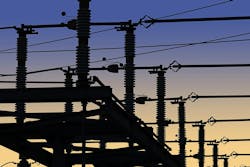Microgrids offer solution to big problem – energy fluctuations
By Ron Shinn
You may be tired of hearing about Industry 4.0, either because you already take it for granted as necessary for your day-to-day operations, or you never think about it because your plant is running just fine without it.
But in addition to making it possible for your machines to communicate with each other and deliver actionable data to digital and human decision-makers, Industry 4.0 might help prevent your plant from grinding to a halt when electrical power fails. It all has to do with microgrids and the ability of digital manufacturing systems to respond quickly to fluctuating power supplies.
First, a little background is needed.
This country’s 100-year-old electrical grid is a patchwork of systems operated by independent companies that have rarely focused on investing for long-term needs. Now there are significant new demands on the grid from the likes of electric vehicles, cryptocurrency farms, extreme weather and a growing population.
Is this a real problem for plastics processors? Brent Tracey, manufacturing sector lead for Duke Energy Sustainable Solutions, said in a recent article that there has been a 67 percent increase in major power outages from weather-related events since 2000, and that 58 percent of manufacturing businesses reported an outage lasting more than one hour.
What is the cost of your plant going dark for an hour, then having to restart all its machinery?
We have more than 300,000 miles of transmission lines and other infrastructure that is designed simply to move electricity from power plants to homes and factories.
Power generation from fossil fuels and coal is declining. This is somewhat offset by solar and wind generation, but the grid is not designed to easily connect and transmit power from these sources. There are currently more than 11,000 pending applications from wind, solar and other power generators to connect to the grid, which lacks capacity to accommodate them.
Replacing the current grid with a nationwide smart grid that can move electricity in two directions will take years and cost billions of dollars. But microgrids are an interesting intermediate alternative that could keep your processing machines humming.
It turns out that Industry 4.0 can play a critical role in your ability to take advantage of a microgrid.
Microgrids are small, local energy delivery systems built around solar arrays, wind farms or even excess electricity stored in electric vehicles. Most of today’s microgrids have been built for islands, military bases, universities and medical campuses. But industrial parks, where many plastics processing plants are located, could also be candidates for a microgrid.
The key to making a microgrid work in an industrial park is for the grid to be able to respond quickly to fluctuating energy demand. Industry 4.0 underlies the digital manufacturing process and can link processing machines to an industrial park’s microgrid.
According to W. David Stephenson, CEO of Stephenson Strategies, a consultancy specializing in Internet of Things (IoT), writing recently on the Industry Week website, large factories with internal power generation and large commercial or industrial building complexes with local power generation often can use lower voltages – such as those generated by local microgrids -- than the main grid provides.
The 2022 Bipartisan Infrastructure Law and the Inflation Reduction Act included $30 billion for developing smart grids, which include microgrids, in both public and private sectors.
Could a microgrid be in your future? Don’t back away if the owner of your industrial park mentions the idea. It could reduce your energy costs, provide power stability and help you meet your environmental goals.
Microgrids are built on the same digital technology as Industry 4.0. That means supply and demand can be instantly matched, an important requirement for microgrids.
An alternative to being part of a microgrid is to install on-site power generation to support your plant. It could be your emergency backup, used only at peak usage times to save money, or run continuously. That means you would no longer be entirely dependent on grid power, but do-it-yourself costs could be high.
Most plant owners would agree that the best power is power they do not have to buy. So while you are thinking about electric power, check out two new stories by Senior Staff Reporter Bruce Geiselman:
- APenergy consultant Matt Flanigan says plastics processors can use incentive programs to partially or fully pay for improvements that save money and reduce carbon emissions.
- SensXpert CEO Cornelia Beyer explains how sensors, along with artificial intelligence and machine-learning technologies, can optimize processing and save energy.
Ron Shinn, editor
About the Author
Ron Shinn
Editor
Editor Ron Shinn is a co-founder of Plastics Machinery & Manufacturing and has been covering the plastics industry for more than 35 years. He leads the editorial team, directs coverage and sets the editorial calendar. He also writes features, including the Talking Points column and On the Factory Floor, and covers recycling and sustainability for PMM and Plastics Recycling.

